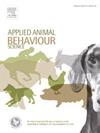Handle with care: Dogs show negative responses to restrictive handling restraints and tools during routine examinations
IF 2.2
2区 农林科学
Q1 AGRICULTURE, DAIRY & ANIMAL SCIENCE
引用次数: 0
Abstract
Routine veterinary visits are important for monitoring dog welfare; however, handling during physical examinations may elicit fear responses in dogs. Although handling recommendations exist to mitigate negative experiences for dogs, there is little empirical evidence to support these handling recommendations. Thus, this study aimed to investigate the influence of handling techniques and tools on dog behavioral and physiological responses during routine veterinary examinations. A total of 97 dogs were recruited from a local municipal shelter. Using a randomized block design balanced for age (mean age was 3.5), sex (49 female, 48 male), and size (40 small, 57 medium/large), dogs were randomly sorted into one of five treatments: 1) passive restraint, 2) muzzle-hold restraint, 3) basket muzzle, 4) soft muzzle, and 5) full-body restraint. A willingness-to-approach test was conducted to assess sociability toward the handler, followed by a handling phase (2-minute examination while in the handling treatment), and a post-handling phase (30-second observation period). Behavioral responses (posture reductions, lip licking, yawning, vocalizing, elimination, body shaking, trembling, avoidance, escape) were measured during the handling and post-handling phases, and physiological responses (temperature, respiratory and heart rate) were recorded during handling. A scale used to measure fear was also assessed during each phase using a 5-item scale (0 =no fear, 4 =extreme fear). Results indicated that across treatments, most dogs showed reduced posture during handling (63 %, 61/97), and neutral posture post-handling (95 %, 92/97). During handling, dogs in the muzzle-hold restraint displayed more escape attempts (p = 0.009) and dogs that received the full-body restraint performed more vocalizations (p = 0.008) compared to dogs in the passive restraint. It took longer to place dogs in the soft (p = 0.001) and basket muzzle (p<0.001) compared to the passive restraint. Dogs in the soft muzzle were more likely to display avoidance behaviors (p<0.001) than dogs in passive restraint. Physiological measurements did not vary by treatment group. Fear scores were lower during handling in passive restraint compared to all other treatments: muzzle-hold (p=0.001), basket muzzle (p=0.0157), soft muzzle (p=0.0001), and full-body restraint (p=0.0001). Results suggest that dogs display more negative responses when handled with the muzzle-hold and full-body restraints, compared to passive restraint and use of muzzle tools. This study can be used to inform evidence-based recommendations and support the implementation of less restrictive handling to mitigate stress for dogs during routine examinations.
求助全文
约1分钟内获得全文
求助全文
来源期刊

Applied Animal Behaviour Science
农林科学-行为科学
CiteScore
4.40
自引率
21.70%
发文量
191
审稿时长
18.1 weeks
期刊介绍:
This journal publishes relevant information on the behaviour of domesticated and utilized animals.
Topics covered include:
-Behaviour of farm, zoo and laboratory animals in relation to animal management and welfare
-Behaviour of companion animals in relation to behavioural problems, for example, in relation to the training of dogs for different purposes, in relation to behavioural problems
-Studies of the behaviour of wild animals when these studies are relevant from an applied perspective, for example in relation to wildlife management, pest management or nature conservation
-Methodological studies within relevant fields
The principal subjects are farm, companion and laboratory animals, including, of course, poultry. The journal also deals with the following animal subjects:
-Those involved in any farming system, e.g. deer, rabbits and fur-bearing animals
-Those in ANY form of confinement, e.g. zoos, safari parks and other forms of display
-Feral animals, and any animal species which impinge on farming operations, e.g. as causes of loss or damage
-Species used for hunting, recreation etc. may also be considered as acceptable subjects in some instances
-Laboratory animals, if the material relates to their behavioural requirements
 求助内容:
求助内容: 应助结果提醒方式:
应助结果提醒方式:


